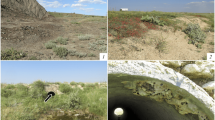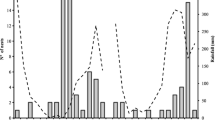Summary
The nesting biology of a mainly solitary bee,Lasioglossum (Dialictus) figueresi, is compared with that of a possible relative and mainly eusocial bee,L. (D.) aeneiventre. These bees nest in the ground in highly disturbed areas in the Meseta Central of Costa Rica. Information is provided on social organization, male production, diel and seasonal activity patterns, pollen utilization, natural enemies and nest architecture.
L. (D.) figueresi nests within aggregations in vertical earthen banks, and 80–90 % of females are solitary during the nest-provisioning phase. Social nests contain two (or rarely three) females which may be either equal or unequal in reproductive status (i.e. mated with developed ovaries or not). Solitary nests and two-female nests do not experience different rates of parasitism. Mid-way through the dry season, females cease provisioning at a time when otherL. (Dialictus) remain active. Females typically remain within their nests, although they occasionally forage for nectar. This behavior is similar of that of “spring gynes” of temperate eusocial species. The egg-to-adult developmental rate ofL. (D.) figueresi is unusually slow for halictine bees, however, so that all the adult females die before their brood eclose in April and May, precluding overlap of generations. The eclosed offspring remain in open cells within their natal nests until mid-June, when both males and females emerge to mate. These newly mated females either establish new nests or re-use old ones.
L. (D.) aeneiventre nests within aggregations in horizontal ground or in vertical banks. A foundress female digs a nest at the beginning of the dry season, although some re-activate old nests. Foundress nests develop into colonies with various kinds of social organization. In contrast toL. (D.) figueresi, L. (D.) aeneiventre is active nearly all year round, except during periods of heavy rain, and produces up to three broods per year.
Sweat bees (Hymenoptera: Halictinae) are a socially heterogeneous group of mainly ground-nesting bees which are abundant world-wide. Intra-specific variation in social behavior is prevalent both within and among populations, presumably indicating social and environmental control of behavioral modifications (see e.g. Sakagami and Munakata, 1972; Eickwort, 1986; Packer, 1990; Yanega, 1988; reviewed in Michener, 1990). The initial stages of hymenopteran social evolution are represented by solitary individuals and those in undifferentiated societies, yet their biology is not well known, as is true for the numerous tropical halictine species or populations (see Michener, 1990).
The subgenusDialictus ofLasioglossum is a primarily New World group of several hundred species (Moure and Kurd, 1987). These bees are monotonously similar in structure and appearance, yet diverse in social behavior. FemaleLasioglossum (Dialictus) figueresi are usually solitary, and structurally are very similar to their social relativeL. (D.) aeneiventre (Wcislo, 1990 a). The systematic placement of these species with respect to otherL. (Dialictus) is uncertain, but they have no obvious affinities to other recognized species groups (G. C. Eickwort, pers. comm.). Unusual morphological features, such as large size, yellowish wings and pubescence, and features of the genital organs, may indicate thatL. (D.) figueresi is the more derived of the pair, and may therefore be secondarily solitary, as is known for other sweat bees (Packer, 1991).
Similar content being viewed by others
References
Anonymous, 1965.Anuario meterologico, año 1965. Institute Meterologico Nacional, Ministerio de Agriculture y Ganaderia, San José, Costa Rica.
Anonymous, 1982.Anuario meterologico, año 1982. Institute Meterologico Nacional, Ministerio de Agricultura y Ganaderia, San José, Costa Rica.
Clark, P. J. and F. C. Evans, 1954. Distance to nearest neighbor as measure of spatial relationships in populations.Ecology 35:445–453.
Coen E., 1982. Climate. In:Costa Rican Natural History (D. Janzen, Ed.). University of Chicago Press, Chicago, pp. 35–45.
Conover, W. J., 1971.Practical Nonparametric Statistics. John Wiley & Sons, Inc., New York.
Eickwort, G. C., 1986. First steps into eusociality: the sweat beeDialictus lineatulus.Fla. Entomol. 69:742–754.
Eickwort, G. C. and P. F. Kukuk, 1990. The relationship between nest architecture and sociality in halictine bees. In:Social Insects and the Environment (Proc. llth Internatl. Congr. IUSSI, Bangalore) (G. K. Veeresh, B. Mallik and C. A. Viraktamath, Eds.). Oxford & IBH Publ. Co., New Delhi, pp. 664–665.
Hicks, C. H., 1931. Notes on certain bees, with a consideration of the use of the abdomen in nest construction.Can Entomol. 63:173–178.
Kamm, D. R., 1974. Effects of temperature, day length, and number of adults on the sizes of cells and offspring in a primitively eusocial bee (Hymenoptera: Halictidae). J. KansasEntomol. Soc. 47:8–18.
Krombein, K. V., P. D. Kurd, Jr., D. R. Smith and B. D. Burks, 1979.Catalog of Hymenoptera in America North of Mexico. Smithsonian Institution Press, Washington D.C. 2735 pp.
Lin, N. and C. D. Michener, 1972. Evolution of sociality in insects. Quart.Rev. Biol 47:131–159.
Linsley, E. G., 1958. The ecology of solitary bees.Hilgardia 27:543–599.
Michener, C. D., 1964. Reproductive efficiency in relation to colony size in hymenopterous insects.Ins. Soc. 11:317–342.
Michener, C. D., 1974.The Social Behavior of the Bees. Harvard University Press, Cambridge, Mass. 404 pp.
Michener, C. D., 1990. Reproduction and caste in social halictine bees. In:Social Insects: An Evolutionary Approach (W. Engels, Ed.). Springer-Verlag, Berlin, Heidelberg, New York, pp. 77–121.
Michener, C. D., E. A. Cross, and H. V. Daly et al., 1958. Additional techniques for studying the behavior of wild bees.Ins. Soc. 2:237–246.
Michener, C. D. and R. B. Lange, 1958. Observations on the behavior of Brasilian halictid bees. V.Chloralictus.Ins. Soc. 5:379–407.
Michener, C. D. and C. A. C. Seabra, 1959. Observations on the behavior of Brasilian halictid bees, VI. Tropical species.J. Kansas Entomol. Soc. 32:19–28.
Michener, C. D. and A. Wille, 1961. The bionomics of a primitively social bee,Lasioglossum inconspicuum.Univ. Kansas Sci. Bull. 42:1123–1202.
Moure, J. S., CMF and P. D. Hurd, Jr., 1987.An Annotated Catalog of the Halictid Bees of the Western Hemisphere (Hymenoptera: Halictidae). Smithsonian Institution Press, Washington D.C. 405 pp.
Packer, L., 1990. Solitary and eusocial nests in a population ofAuglochlorella striata (Provancher) (Hymenoptera: Halictidae) at the northern edge of its range.Behav. Ecol. Sociobiol. 27:339–344.
Packer, L., 1991. The evolution of social behavior and nest architecture in sweat bees of the subgenusEvylaeus (Hymenoptera: Halictidae): a phylogenetic approach.Behav. Ecol. Sociobiol. 29:153–160.
Plateaux-Quénu, C., L. Plateaux and L. Packer, 1989. Biological notes inEvylaeus villosulus (K.) (Hymenoptera: Halictidae), a bivoltine, largely solitary halictine bees.Ins. Soc. 36:245–263.
Rozen, J. G., Jr., 1967. Review of the biology of panurgine bees, with observations on North American forms (Hymenoptera, Andrenidae).Amer. Mus. Nov. 2297:1–44.
Sakagami, S. F. and C. D. Michener, 1962.The Nest Architecture of the Sweat Bees. University of Kansas Press, Lawrence. 135 pp.
Sakagami, S. F. and J. S. Moure CMF, 1967. Additional observations on the nesting habits of some Brazilian halictine bees.Mushi 40:119–138.
Sakagami, S. F. and M. Munakata, 1972. Distribution and bionomics of a transpalearctic eusocial halictine bee,Lasioglossum (Evylaeus) calceatum, in northern Japan, with reference to its solitary life at high altitude.J. Fac. Sci., Hokkaido Univ., Zool. 18:411–439.
Simberloff, D., 1979. Nearest neighbor assessments of spatial configurations of circles rather than points.Ecology 60:679–685.
Sinclair, D. F., 1985. On tests of spatial randomness using mean nearest neighbor distances.Ecology 66:1084–1085.
Sokal, R. R. and F. J. Rohlf, 1981.Biometry (2nd ed.). W. H. Freeman & Co., New York, 859 pp.
Tepedino, V. J., L. L. McDonald and R. Rothwell, 1979. Defense against parasitization in mudnesting Hymenoptera: can empty cells increase net reproductive output?Behav. Ecol. Sociobiol. 6:99–104.
Wcislo, W. T., 1990a. A new species ofLasioglossum from Costa Rica.J. Kansas Entomol. Soc. 63:450–453.
Wcislo, W. T., 1990b. Parasitic and courtship behavior ofPhalacrotophora halictorum (Diptera: Phoridae) at a nesting site ofLasioglossum figueresi (Hymenoptera: Halictidae).Rev. Biol. Trop. 38:205–209.
Wcislo, W. T., 1991.Natural History, Learning, and Social Behavior in Solitary Sweat Bees (Hymenoptera: Halictidae). Ph. D. Dissertation, University of Kansas, Lawrence, 204 pp.
Wcislo, W. T., (in press a). Nest localization and recognition by the solitary bee,Lasioglossum (Dialictus) figueresi Wcislo (Hymenoptera: Halictidae), in relation to sociality. Ethology.
Wcislo, W. T., (1992). Attraction and learning in the mating biology of solitary sweat bees,Lasioglossum (Dialictus) figueresi Wcislo andNomia triangulifera Vachal (Hymenoptera: Halictidae).Behav. Ecol Sociobiol. 31:139–148.
Wenzel, J. W. and J. Pickering, 1991. Cooperative foraging, productivity, and the central limit theorem.Proc. Natl. Acad. Sci. (USA) 88:36–38.
Wille, A. and E. Orozco, 1970. The life cycle and behavior of the social beeLasioglossum (Dialictus) umbripenne (Hymenoptera: Halictidae).Rev. Biol. Trop. 17:199–245.
Yanega, D., 1988. Social plasticity and early-diapausing females in a primitively social bee.Proc. Natl. Acad. Sci., USA 85:4374–4377.
Author information
Authors and Affiliations
Rights and permissions
About this article
Cite this article
Wcislo, W.T., Wille, A. & Orozco, E. Nesting biology of tropical solitary and social sweat bees,Lasioglossum (Dialictus) figueresi Wcislo andL. (D.) aeneiventre (Friese) (Hymenoptera: Halictidae). Ins. Soc 40, 21–40 (1993). https://doi.org/10.1007/BF01338830
Received:
Revised:
Accepted:
Issue Date:
DOI: https://doi.org/10.1007/BF01338830




